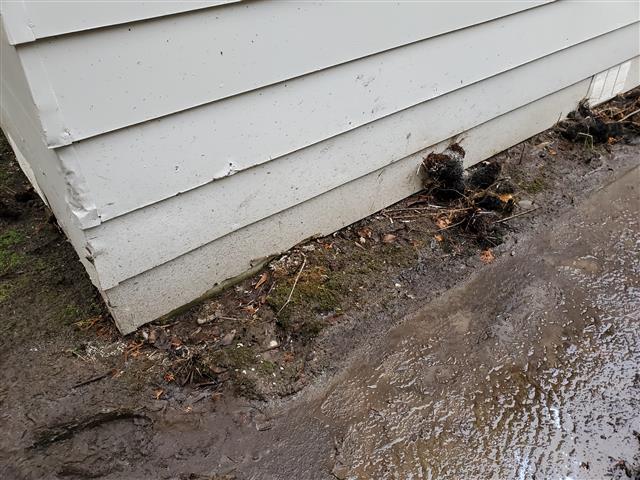
There are different siding clearance requirements based on the type of siding that is installed. However, a gap between the siding and the exterior grade of at least 6-8 inches is advised for most applications.
Often the issue is not that the siding was installed too low, but that the exterior grade is too high. Siding clearance or “foundation exposure” is meant to maintain a break between the natural exterior elements and the susceptible portions of a home. Improper water drainage around a home is a common and serious issue. If the gap between the ground and the siding is inadequate, pooling moisture can make its way into the wooden building components. Without proper clearance wood destroying organisms, such as termites and carpenter ants, also have easier access.

Metal siding is durable and long lasting. However, a lack of proper clearance from the ground can cause the siding to corrode and rust prematurely. This can result in costly repairs. Similarly, vinyl siding, if properly installed, has a long service life. Vinyl siding with poor clearance, particularly when in contact with the ground, can become brittle due to prolonged moisture penetration. A gap of at least 6 inches between the siding and the exterior grade is recommended for these installations.
Fiber cement siding is a newer product that has many benefits. It is resistant to fire, moisture, and pests. However, it is still susceptible to issues related to moisture and pest intrusion when not properly installed. Hardi Plank is the most popular cement fiber manufacturer and they have specific requirements for installations near the ground. They state that a minimum 6-inch gap between the siding and the ground must be present to conform with their installation requirements.
Brick and stone veneer are popular aesthetic siding installations in many areas. Veneers use a drainage method at their base that can be installed in the form of weep holes or weep screeds. The purpose of these components is to allow moisture that forms or enters the air gap behind the veneer to drain out. This drainage method can be impeded when a proper gap between the veneer and the ground is not present. A minimum 6-inches of clearance is recommended.
Stucco and more recently EIFS (Exterior Insulation and Finish System) siding installations also need proper clearance. Newer stucco and EIFS siding should have drainage pathways installed at their base, similar to brick and stone veneers. Inadequate siding clearance can prevent proper drainage, as well as cause moisture absorption and accelerated deterioration. A gap of at least 6 inches should be provided.
In summation, regardless of the time of siding that you have there should be adequate clearance between the siding and the ground. This gap helps to prevent siding deterioration, moisture intrusion, and pest entry. We recommend examining the siding around your home for proper clearance and taking the necessary steps to correct problem areas.
